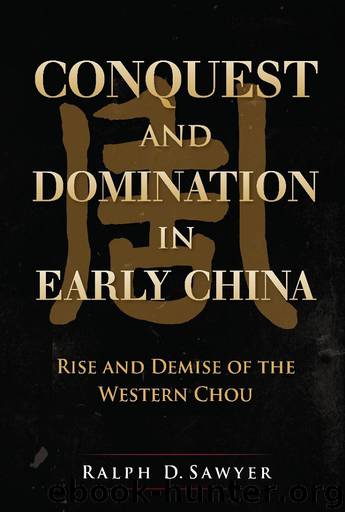Conquest and Domination in Early China: Rise and Demise of the Western Chou by Sawyer Ralph

Author:Sawyer, Ralph [Sawyer, Ralph]
Language: eng
Format: epub
Publisher: CreateSpace
Published: 2013-12-04T16:00:00+00:00
12
Postsuppression Measures
T he historical vestiges that depict the second conquest convey a sense that rather than simply resolving internal strife or engaging in a civil war, a “world war” had been fought over a major portion of the contiguous terrain. Chou military forces did not just suppress recalcitrant elements but also succeeded in imposing a greater degree of control over the realm, enabling the government to embark on a vigorous program of consolidation despite the continued existence of heterogeneous elements and unsubmissive pockets. Even if not yet fully actualized, their dream of dominance had now become achievable. Radiating out from Shaanxi, Chou control stretched into southern Hebei in the northeast, out to Shandong and Po-hai in the east, across Henan, and down to northern Hubei, Anhui, and Jiangsu in the southeast. Despite unsubstantiated claims of southern campaigns having been mounted, 555 the south remained hostile territory, but Shanxi fell well within their purview. Not counting any coalition forces, the Chou may have fielded as many as five independent armies in order to realize these results.
Insofar as the Chou had certainly been unable to impose many taxes, labor obligations, or ritual constraints during King Wu’s short, two-year reign, the so-called rebellions of the Tung Yi and Huai Yi probably amounted to the more powerful groups and protostates refusing to acknowledge Chou authority. Despite not having deployed any forces in this area nor having established any peripheral fiefs that had come under attack, Chou leaders were sufficiently inflamed by what they perceived as the Tung Yi and Huai Yi’s presumptuousness to target them for military action. So immersed in their quest for domination, so enraged that others had failed to accept Heaven’s mandate, the oligarchs were willing to wage battle far afield, contrary to their long-avowed policy of accommodation.
Whether the Shang revolt had been mostly verbal, centered on the person of Wu Keng but with little armed support, or had involved numerous members of the warrior nobility and whatever military forces had been reconstituted to ensure tranquility after the first conquest, remains uncertain. King Wu’s brothers must have mobilized their troops but apparently waited to be attacked instead of seizing the initiative and forcefully acting. Wu Keng similarly remained passive, suggesting he had become saddled with groundless claims that he was seeking to restore the Shang and displace the Chou when he had merely been voicing his displeasure and rejecting continued Chou dominance. As no egregious or aggressive actions are recorded—and it is hard to imagine they would not occupy a prominent place in the historical records, given their contravention of the newly sacred order—Wu Keng’s ambitions must have greatly exceeded his strategic competence.
Assertions that the subsequently well-known Eight Yin Armies had already been created from remnants of the Shang forces and therefore participated in the revolt, perhaps furnishing the key forces under Kuan-shu and Ts’ai-shu, are highly questionable. The leniency of postconquest Chou measures and the large number of people shifted to other enclaves also suggest a limited scope to the
Download
This site does not store any files on its server. We only index and link to content provided by other sites. Please contact the content providers to delete copyright contents if any and email us, we'll remove relevant links or contents immediately.
| Africa | Americas |
| Arctic & Antarctica | Asia |
| Australia & Oceania | Europe |
| Middle East | Russia |
| United States | World |
| Ancient Civilizations | Military |
| Historical Study & Educational Resources |
The Daily Stoic by Holiday Ryan & Hanselman Stephen(3210)
The Fate of Rome: Climate, Disease, and the End of an Empire (The Princeton History of the Ancient World) by Kyle Harper(2988)
People of the Earth: An Introduction to World Prehistory by Dr. Brian Fagan & Nadia Durrani(2690)
Ancient Worlds by Michael Scott(2607)
Babylon's Ark by Lawrence Anthony(2550)
The Daily Stoic by Ryan Holiday & Stephen Hanselman(2440)
Foreign Devils on the Silk Road: The Search for the Lost Treasures of Central Asia by Peter Hopkirk(2421)
India's Ancient Past by R.S. Sharma(2401)
MOSES THE EGYPTIAN by Jan Assmann(2360)
The Complete Dead Sea Scrolls in English (7th Edition) (Penguin Classics) by Geza Vermes(2222)
Lost Technologies of Ancient Egypt by Christopher Dunn(2185)
The Earth Chronicles Handbook by Zecharia Sitchin(2166)
24 Hours in Ancient Rome by Philip Matyszak(2041)
Alexander the Great by Philip Freeman(2025)
Aztec by Gary Jennings(1961)
The Nine Waves of Creation by Carl Johan Calleman(1870)
Curse Tablets and Binding Spells from the Ancient World by Gager John G.;(1828)
Before Atlantis by Frank Joseph(1801)
Earthmare: The Lost Book of Wars by Cergat(1780)
